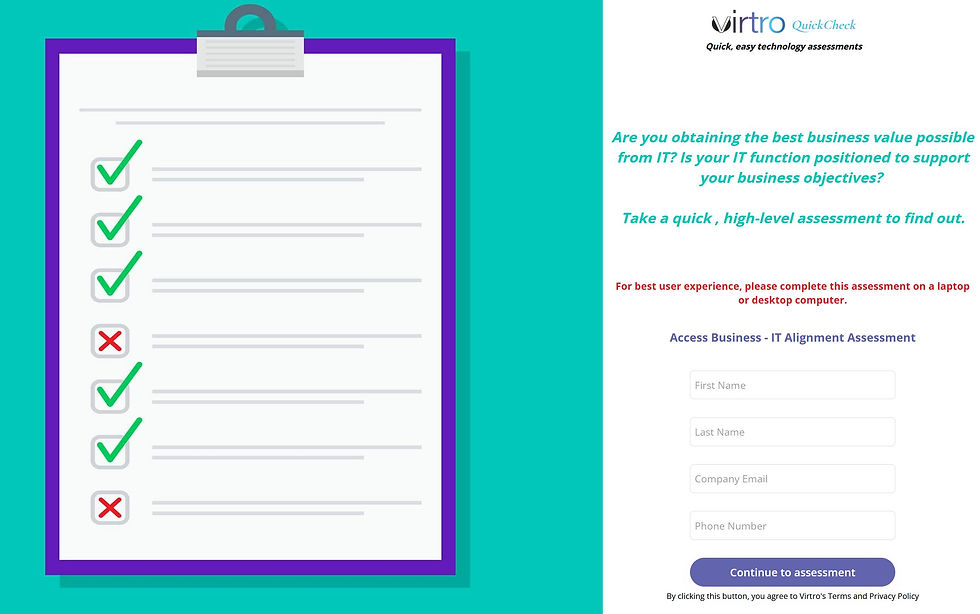Assessing Business - IT Alignment
- Virtro Consulting Ltd.
- Nov 21, 2023
- 3 min read
Business - IT Alignment Series
Over the last couple of weeks, we have been discussing the crucial subject of Business - IT Alignment. We defined what it means for an organization to have Business - IT alignment and discussed the benefits of alignment. We also discussed how a business-aligned technology strategy is fundamental to ensuring that IT is aligned to the business, and explored how to ensure ongoing Business - Alignment. These topics are contained in our series of blog posts on Business - IT Alignment.
In this post, we switch our attention to discussing how an organization may assess the degree to which its technology function is aligned to and enables the realization of business objectives. Business - IT Alignment is not binary i.e. an organization’s technology function is not either aligned with the business completely or not aligned with the business at all. In reality, Business - IT Alignment is a continuum and organizations tend to fall somewhere between being fully aligned or not at all.
When there is a low degree of alignment between a business and its IT function, the organization will experience suboptimal partnership between business and IT, leading to one or more of the following:
Sustained or increasing occurrence of incidents, and slow resolution when incidents occur
Unsatisfied end users and customers
Suboptimal technology support for business processes
Less than desired returns on IT investments
Slower pace of innovation
Increased lead to reduce products and updates to market
How can an organization avoid the issues listed above? How can an organization establish the degree to which its IT function is aligned with and enables the business?
How to conduct a Business - IT Alignment Assessment
Define purpose of assessment: the first thing to establish is why the organization wants to carry out an assessment. In this case, the reason is to determine the degree of Business - IT Alignment.
Define assessment scope: since the goal of the assessment is to validate the degree of Business - IT Alignment, the scope of the assessment should include the entire IT function. There are cases however that the scope of the assessment may be limited to a specific sub-function within IT depending on the goals of the business e.g. product development.
Prepare assessment: with the scope determined, the assessment questions designed to assess the in-scope areas of the IT function are documented. For most organizations, preparing the assessment is reduced to identifying an assessment tool that covers the scope of the intended assessment or engaging a consultant to assess Business - IT Alignment.
Take assessment: suitable personnel from the organization complete the assessment and an assessment report is prepared or generated. The report should indicate areas of the IT function that are aligned with the business, somewhat aligned or not aligned with the business.
Prioritize gaps: typically, not all gaps identified are prioritized equally. Prioritization of gaps is a function of one or more drivers. These may include criticality of the gap, urgency of business need, resource/ budget available, dependency on other gaps, etc.
Define improvement plan: prioritization of gaps are reflected in an improvement plan.
Virtro’s high-level business - IT alignment app
Here at Virtro Consulting, we offer VirtroQuickCheck, a free assessment to help businesses determine very quickly how well an organization’s IT function is aligned to business capabilities and objectives.

Virtro’s QuickCheck Business - IT Alignment Assessment Tool - Landing Page.
Through QuickCheck, organizations can answer a few questions on different focus areas including, but not limited to the Business Baseline, Business Objectives and Plans, Industry Dynamics and Trends, Business and Technology imperatives, IT Spend Drivers, etc. and a report will be generated for them.

Virtro’s QuickCheck Business - IT Alignment Assessment Tool - Sample Assessment Report.
The assessment report generated indicates the focus area that an assessment question deals with, the question asked, response provider by the user, feedback provided to the user and a RAG status which serves as a visual representation of the feedback provided to the user. It is important to note that the feedback provided to the user is not a recommendation. We would need more context to make actual recommendations on how to address alignment gaps identified.
With an assessment report in place, organizations can go ahead and prioritize these gaps based on their unique circumstances and to define a plan to close these gaps.
Get Started
An IT capability assessment helps identify technology capability gaps. Closing these gaps are crucial to positioning the IT function to effectively support the business and enable the realization of business objectives.
Virtro enables digital transformation by helping municipalities and SMBs develop strategy-aligned IT capability maps, determine IT capability gaps and develop IT Strategy documents. Contact us to discuss or schedule a free consultation.
If you are wondering about how well your business and IT are aligned, consider taking Virtro's free, high-level Business - IT Alignment Assessment.
Please share your thoughts and comments below.






Comments